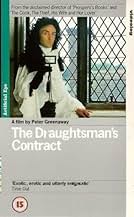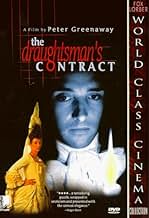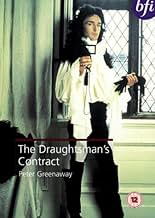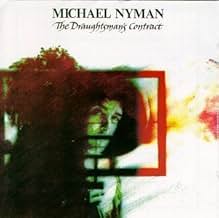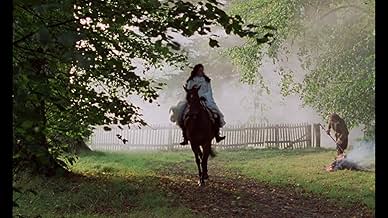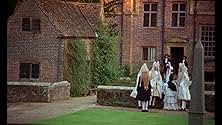AVALIAÇÃO DA IMDb
7,2/10
12 mil
SUA AVALIAÇÃO
A esposa de um rico proprietário de terras encomenda a um jovem artista uma série de desenhos da propriedade enquanto seu marido está fora.A esposa de um rico proprietário de terras encomenda a um jovem artista uma série de desenhos da propriedade enquanto seu marido está fora.A esposa de um rico proprietário de terras encomenda a um jovem artista uma série de desenhos da propriedade enquanto seu marido está fora.
- Direção
- Roteirista
- Artistas
- Prêmios
- 1 vitória e 4 indicações no total
Anne-Louise Lambert
- Mrs. Talmann
- (as Anne Louise Lambert)
Nicholas Amer
- Mr. Parkes
- (as Nicolas Amer)
Lynda La Plante
- Mrs. Clement
- (as Lynda Marchal)
Alastair G. Cumming
- Philip - Mr. Neville's assistant
- (as Alastair Cummings)
Avaliações em destaque
Mr. Neville is a young arrogant artist full of himself. He is contracted to make landscape estate drawings by Mrs. Virginia Herbert. She has a bitter relationship with her wealthy landowning husband who leaves on a trip. She submits to Neville sexually as part of the contract. There is also her daughter Mrs. Talmann and her husband Mr. Talmann. The couple is childless taking care of his nephew. Mrs. Herbert tries to revoke the contract but Neville refuses. Mrs. Talmann blackmails Neville into entering a similar contract pointing out items in his drawings which indicate "misadventure". When Mr. Herbert is found dead in the moat, Neville is horrified to discover that he's the leading suspect.
This is an unusual film. It's a Shakespearian sex romp with a murder mystery. The style has long takes and mid to long distance visuals. The movie lost me the first time around. It can meander and the story can be mercurial. It would help a lot if the murder is shown even if the perpetrators are not. The individual clues need accompanying flashbacks to show that part of the crime. This has a certain amount of beauty and weird originality but it's not easy for everyone.
This is an unusual film. It's a Shakespearian sex romp with a murder mystery. The style has long takes and mid to long distance visuals. The movie lost me the first time around. It can meander and the story can be mercurial. It would help a lot if the murder is shown even if the perpetrators are not. The individual clues need accompanying flashbacks to show that part of the crime. This has a certain amount of beauty and weird originality but it's not easy for everyone.
Being of English origin the film has a particular fascination. Certain things become apparent if you know England well, but also I suspect on repeated viewing.
A tale of conceit, deception and power. The conceit of the Draughtsman, all too apparent, is matched by the conceit of the upper classes as the film unfolds. The pictoral conceit referred to in the film repeatedly is matched by a pictoral conceit played on the viewer: the wigs were never that big, the house, garden and grounds stunning and the weather too perfect.
Deception exists at many levels. The viewer is deceived as to where the houses and events take place. The allusions are to Southampton and surrounding areas. Being from the Southampton area I realized this wasn't Southampton. Though it could possibly have been. The deception was convincing. The location is Kent. I believe this deception, which fits so nicely in the film anyway, was pulled so that the owner of the house where the film is centred around would not be invaded by tourists. A nice touch which I suspect follows the line in the film, something like this), "Do you think Mrs Talbot is a lady who likes her gravel being kicked around by a pack of dogs."
The arrogance and exploitation of the ladies of the house by the Draughtsman, readily apparent, is more sinisterly exceeded by the arrogance and exploitation of the Draughtsman by the ladies. The Draughtsman provides a cover for murder, solves the problem of transfer of the property by siring a child and finally ends up as the scapegoat for murder. While the Draughtsman may appear to be playing with the household for his own amusement, the Draughtsman himself is the focus of a much more brutal and more deadly game.
Like all the best films there is much going on in the film. The lines and language are wonderfully rich. The camera merely shows you the events. And it is not above deceiving you as a viewer. Trying to make sense of it all is great fun. Many things I didn't even see until the second or third viewing, let alone make sense of them!
A beautiful allegory which slowly unfolds and challenges the senses. Much like The Prisoner (1967) tv series, and hopefully The Prisoner (2000) movie.
A tale of conceit, deception and power. The conceit of the Draughtsman, all too apparent, is matched by the conceit of the upper classes as the film unfolds. The pictoral conceit referred to in the film repeatedly is matched by a pictoral conceit played on the viewer: the wigs were never that big, the house, garden and grounds stunning and the weather too perfect.
Deception exists at many levels. The viewer is deceived as to where the houses and events take place. The allusions are to Southampton and surrounding areas. Being from the Southampton area I realized this wasn't Southampton. Though it could possibly have been. The deception was convincing. The location is Kent. I believe this deception, which fits so nicely in the film anyway, was pulled so that the owner of the house where the film is centred around would not be invaded by tourists. A nice touch which I suspect follows the line in the film, something like this), "Do you think Mrs Talbot is a lady who likes her gravel being kicked around by a pack of dogs."
The arrogance and exploitation of the ladies of the house by the Draughtsman, readily apparent, is more sinisterly exceeded by the arrogance and exploitation of the Draughtsman by the ladies. The Draughtsman provides a cover for murder, solves the problem of transfer of the property by siring a child and finally ends up as the scapegoat for murder. While the Draughtsman may appear to be playing with the household for his own amusement, the Draughtsman himself is the focus of a much more brutal and more deadly game.
Like all the best films there is much going on in the film. The lines and language are wonderfully rich. The camera merely shows you the events. And it is not above deceiving you as a viewer. Trying to make sense of it all is great fun. Many things I didn't even see until the second or third viewing, let alone make sense of them!
A beautiful allegory which slowly unfolds and challenges the senses. Much like The Prisoner (1967) tv series, and hopefully The Prisoner (2000) movie.
Is Greenaway our most intelligent filmmaker? One of them at least. He is master of lush self-referential allegory. Here this is hung on a mystery masquerading as restoration comedy. Just maintaining the period and manner is quite a feat.
Self-reference. The film is about an artist who creates rich images that include incongruous elements. The arrogance of the artist is balanced by his blindness as to the meaning, the context of what the images reveal. Both the artist and the viewers are confused by the meaning and flummoxed by the events that the meaning triggers. Greenaway clearly means this to extend to himself, his film and the incompleteness of what we the viewers see. The drawings and the drawer's hands are in fact his.
Fantasy-allegory. This is a film richer in symbology than Drowning and Cook, but probably less so than the later `book' movies. Great attention has been spent on recondite supplementary images, including a central painting in the house being itself painted by the draftsman and filmmaker. I viewed it (the whole film) once just for details. The living statue is only the most obvious illogical element, and in fact draws attention away from other smaller visual diversions.
Mystery artifice. The whole environment is one of genteel artifice, hiding cruel mechanics of conspiracy. The cleverness of the construction is that Greenaway and us are full conspirators. No one, not us, him or the characters shown fully understand what is going on. The mystery form has always been a dialog between artist and consumer, a contest to see who can outwit whom. Very clever use of the mystery form here to include us in the artifice by not ever `playing fair.'
Restoration comedy. Past the visual allegory and the fantasy mystery and the self-reference is a restoration comedy which taken straight is hilarious. The statue is from this form.
My only criticisms are minor. This film contains a restrained story, and incidentally all sex takes place offscreen. Why be so conservative in these areas? Also, Lady Herbert required a more powerful actress I think.
Self-reference. The film is about an artist who creates rich images that include incongruous elements. The arrogance of the artist is balanced by his blindness as to the meaning, the context of what the images reveal. Both the artist and the viewers are confused by the meaning and flummoxed by the events that the meaning triggers. Greenaway clearly means this to extend to himself, his film and the incompleteness of what we the viewers see. The drawings and the drawer's hands are in fact his.
Fantasy-allegory. This is a film richer in symbology than Drowning and Cook, but probably less so than the later `book' movies. Great attention has been spent on recondite supplementary images, including a central painting in the house being itself painted by the draftsman and filmmaker. I viewed it (the whole film) once just for details. The living statue is only the most obvious illogical element, and in fact draws attention away from other smaller visual diversions.
Mystery artifice. The whole environment is one of genteel artifice, hiding cruel mechanics of conspiracy. The cleverness of the construction is that Greenaway and us are full conspirators. No one, not us, him or the characters shown fully understand what is going on. The mystery form has always been a dialog between artist and consumer, a contest to see who can outwit whom. Very clever use of the mystery form here to include us in the artifice by not ever `playing fair.'
Restoration comedy. Past the visual allegory and the fantasy mystery and the self-reference is a restoration comedy which taken straight is hilarious. The statue is from this form.
My only criticisms are minor. This film contains a restrained story, and incidentally all sex takes place offscreen. Why be so conservative in these areas? Also, Lady Herbert required a more powerful actress I think.
"I think my films are always quite self-reflexive and always question 'why am I doing this, is this the right way to do it, what is cinema for, does it have a purpose?"
I'm glad I could find that quote from the man responsible of that film that had me scratching my head for hours and whistling its infectiously catchy tune. Indeed, Peter Greenaway's "The Draughtsman's Contract", directed in 1982, is one of these films that defy analysis and can only be approached through sketches drawn on your own intuition's boards, I watched it three times in a row and I know now that a fourth time will do no good.
And so I figured "what the heck?"... maybe there are some movies that are deliberately unreachable because even the author would fail to be explicit without betraying his own vision. Though I know some would label that film as pretentious nonsense, Greenaway's quote is the perfect getaway: he doesn't aim at the viewers with his films, he doesn't even aim at himself, what he knows is that the film comes from his own inspiration and that's what matters, the rest belongs to cinema.
But I'm sure I would have joined the bandwagon of criticism if it wasn't for one thing the film gets right and that any viewer can agree with: its photogenic beauty. After all, this is a film set in 1695 and so the baroque style invites itself into the picture and we have these intimate shots embedded in stark contrasts like in Caravaggio's paintings, not to mention an orgy of costume designs and make-up combining the most grotesque extremes of the so-called civilized world.
Greenaway while delighting your eyes with such visual marvels also provides great landscape shots that for once, serve a purpose and aren't there to look pretty on the camera. And so we have the beauty and simplicity of geometry and the treacherous nature of the upper-class waltzing together under the triumphant music of Michael Nymar, inspired by Henry Purcell. To put it simply, this is a film that is beautiful to look at and listen to, but that shouldn't take away the bizarreness of the plot..
In fact, the opening prepares to it with many conversations about architecture, one about many streaks of reservoirs dug under an estate could foreshadow the web of intrigues, and it reminded me of the reputation of the Versailles Palace in France, which as beautiful as it was, couldn't cover the stink in the corridors, visitors satisfying their urgent needs in hidden corners. But I'm digressing, let's get back to the film.
The film centers on a landscaper Mr. Neville (Anthony Haggins) who's too arrogant not to be a real ace in his trade, and there are two aristocratic couples: Mr. And Mrs. Herbert (Dave Hill and Janet Suzman) and their daughter and son-in-law the Talmans (Anne-Louise Lambert and Hugh Fraser). Neville signs a contract with the mother (let's call her that way for the sake of clarity), he must produce twelve landscape drawings of her country house, gardens and outbuildings included. Then Nevill adds a clause that's so special I could only copy-paste it: to meet Mr. Neville in private and to comply with his requests concerning his pleasure with me."
O tempora, o mores... I guess. Anyway, the sequences showing the process of sketching are fantastic to watch and the music just brings that energy that seems to prepare you to something. And then there's the mystery with many needless details intruding in the drawings: empty boots, a ladder, anything that look too incongruous but whose presence seem to prepare for something. There is also an odd man disguised as a statue and who doesn't do anything but appear but he, too must be there for a purpose.
Meanwhile, interactions consist merely on the mother honoring her part of the contract (not that she takes pleasure out of it), and Neville making fun of her son-in-law. Needless to say that Neville makes many enemies during the journey and when they try to cancel the contract, he refuses and one thing leading to another, it's the daughter taking the mother's place (since she inherited from her mother the talent to get the wrong man).
There's a lot going on, inheritance problems, absence of children, everything building up to a murder that occurs at two thirds of the film. And when you think that Neville had the making of a suave villain, he becomes the victim of his own shenanigans and his cockiness ends up backfiring at him, making him learn the hart way that one can't be pompous too long and as they say in French, the man just farted higher than his own... bottom. And at that point I won't spoil the rest of the film.
What Greenaway tried to express in his exhilaration of art and through its parallel with the things of flesh, a quest for pleasure within the work or maybe how an artist is immediately an outcast in his world. There's also a strange combination between the rigorism of his work and they way he lets loose details interfere with it, as if by lowering his guard that little, he would cause his own demise.
Anyway, I learned to lower my guard a little too and not expect to get a film, I'm sure there is a riddle in the film that wouldn't be solved even after ten times of viewing but I guess this is the kind of movies that tells pretty much something about the artist as much as it does about the art, and when he doesn't tell, it shows.
One valid and simple criticism, maybe Greenaway got carried away with the lighting and the wigs that he made it difficult to figure who's who (even the mother and daughter looked like they could be sisters).
I'm glad I could find that quote from the man responsible of that film that had me scratching my head for hours and whistling its infectiously catchy tune. Indeed, Peter Greenaway's "The Draughtsman's Contract", directed in 1982, is one of these films that defy analysis and can only be approached through sketches drawn on your own intuition's boards, I watched it three times in a row and I know now that a fourth time will do no good.
And so I figured "what the heck?"... maybe there are some movies that are deliberately unreachable because even the author would fail to be explicit without betraying his own vision. Though I know some would label that film as pretentious nonsense, Greenaway's quote is the perfect getaway: he doesn't aim at the viewers with his films, he doesn't even aim at himself, what he knows is that the film comes from his own inspiration and that's what matters, the rest belongs to cinema.
But I'm sure I would have joined the bandwagon of criticism if it wasn't for one thing the film gets right and that any viewer can agree with: its photogenic beauty. After all, this is a film set in 1695 and so the baroque style invites itself into the picture and we have these intimate shots embedded in stark contrasts like in Caravaggio's paintings, not to mention an orgy of costume designs and make-up combining the most grotesque extremes of the so-called civilized world.
Greenaway while delighting your eyes with such visual marvels also provides great landscape shots that for once, serve a purpose and aren't there to look pretty on the camera. And so we have the beauty and simplicity of geometry and the treacherous nature of the upper-class waltzing together under the triumphant music of Michael Nymar, inspired by Henry Purcell. To put it simply, this is a film that is beautiful to look at and listen to, but that shouldn't take away the bizarreness of the plot..
In fact, the opening prepares to it with many conversations about architecture, one about many streaks of reservoirs dug under an estate could foreshadow the web of intrigues, and it reminded me of the reputation of the Versailles Palace in France, which as beautiful as it was, couldn't cover the stink in the corridors, visitors satisfying their urgent needs in hidden corners. But I'm digressing, let's get back to the film.
The film centers on a landscaper Mr. Neville (Anthony Haggins) who's too arrogant not to be a real ace in his trade, and there are two aristocratic couples: Mr. And Mrs. Herbert (Dave Hill and Janet Suzman) and their daughter and son-in-law the Talmans (Anne-Louise Lambert and Hugh Fraser). Neville signs a contract with the mother (let's call her that way for the sake of clarity), he must produce twelve landscape drawings of her country house, gardens and outbuildings included. Then Nevill adds a clause that's so special I could only copy-paste it: to meet Mr. Neville in private and to comply with his requests concerning his pleasure with me."
O tempora, o mores... I guess. Anyway, the sequences showing the process of sketching are fantastic to watch and the music just brings that energy that seems to prepare you to something. And then there's the mystery with many needless details intruding in the drawings: empty boots, a ladder, anything that look too incongruous but whose presence seem to prepare for something. There is also an odd man disguised as a statue and who doesn't do anything but appear but he, too must be there for a purpose.
Meanwhile, interactions consist merely on the mother honoring her part of the contract (not that she takes pleasure out of it), and Neville making fun of her son-in-law. Needless to say that Neville makes many enemies during the journey and when they try to cancel the contract, he refuses and one thing leading to another, it's the daughter taking the mother's place (since she inherited from her mother the talent to get the wrong man).
There's a lot going on, inheritance problems, absence of children, everything building up to a murder that occurs at two thirds of the film. And when you think that Neville had the making of a suave villain, he becomes the victim of his own shenanigans and his cockiness ends up backfiring at him, making him learn the hart way that one can't be pompous too long and as they say in French, the man just farted higher than his own... bottom. And at that point I won't spoil the rest of the film.
What Greenaway tried to express in his exhilaration of art and through its parallel with the things of flesh, a quest for pleasure within the work or maybe how an artist is immediately an outcast in his world. There's also a strange combination between the rigorism of his work and they way he lets loose details interfere with it, as if by lowering his guard that little, he would cause his own demise.
Anyway, I learned to lower my guard a little too and not expect to get a film, I'm sure there is a riddle in the film that wouldn't be solved even after ten times of viewing but I guess this is the kind of movies that tells pretty much something about the artist as much as it does about the art, and when he doesn't tell, it shows.
One valid and simple criticism, maybe Greenaway got carried away with the lighting and the wigs that he made it difficult to figure who's who (even the mother and daughter looked like they could be sisters).
The first Peter Greenaway's feature "The Draughtsman's Contract" (1982) - is absolutely delightful, devilishly clever (just imagine the best Agatha Christy's mystery with all sorts of clues and suspects but without Poirot or Ms. Maple to explain in the end whodunit and why. You are on your own to try to figure out - everything you need to know is right there), and funny (Yes, Greenaway can be funny!) art film - the perfect example of an art film. It combines the elements of social satire with murder mystery, meditates on the power of art and role of an artist, studies family drama and mothers -daughters love and understanding, perfectly wraps it in sensual pleasure - and what the pleasure it is. I know I will watch it again because it is a feast for eyes (I've seen big budget movies that looked plain comparing to this one shot on the limited funds), ears (Michael Nyman wrote one of the best score ever for this film) and for brain - there are mysteries and puzzles in every frame and in every dialog.
There is couple of Greenaway's thoughts on his first film and on the films that influenced him from the interview that was published in L'Avant-Scene Cinema", No 333, October 1984:
"Majority of my films may be viewed on several levels. Thus, in "The Draughtsman's Contract" there was the desire to open the symbolism of plants and fruits, to study the connections between the aristocrats and the common people, the conflicts between the worlds of gentlemen and of servants. With my films, I hope to generate interest, to stimulate imagination, to wake feelings...
I consider that 90% of my films one way or another refers to paintings. "Contract" quite openly refers to Caravaggio, Georges de la Tour and other French and Italian artists...
Before the work on the film began, I did not explain to film crew what I wanted, but I showed them five European films: "Fellini's Casanova", "The Last Tango in Paris" by Bertolucci, "The Marquise of O" by Eric Rohmer, "Chronicle of Anna Magdalena Bach" by Jean-Marie Straub and, most importantly, "Last Year at Marienbad" by Alain Resnais which has been the most influential film for me."
There is couple of Greenaway's thoughts on his first film and on the films that influenced him from the interview that was published in L'Avant-Scene Cinema", No 333, October 1984:
"Majority of my films may be viewed on several levels. Thus, in "The Draughtsman's Contract" there was the desire to open the symbolism of plants and fruits, to study the connections between the aristocrats and the common people, the conflicts between the worlds of gentlemen and of servants. With my films, I hope to generate interest, to stimulate imagination, to wake feelings...
I consider that 90% of my films one way or another refers to paintings. "Contract" quite openly refers to Caravaggio, Georges de la Tour and other French and Italian artists...
Before the work on the film began, I did not explain to film crew what I wanted, but I showed them five European films: "Fellini's Casanova", "The Last Tango in Paris" by Bertolucci, "The Marquise of O" by Eric Rohmer, "Chronicle of Anna Magdalena Bach" by Jean-Marie Straub and, most importantly, "Last Year at Marienbad" by Alain Resnais which has been the most influential film for me."
Você sabia?
- CuriosidadesDirector Peter Greenaway, a former art student, created the sketches that feature in the film. In fact the close-up shots of the draughtsman drawing are of his hands.
- Erros de gravaçãoThe cooing of a collared dove is not a sound that would have fallen on Jacobean ears, as the species was unknown in Britain until 1955.
- Citações
Mr. Neville: You must forgive my curiosity, madam, and open your knees.
- Versões alternativasWhen Peter Greenaway screened the movie at festivals in 1982, it ran a full three hours. Included in this footage is a full and further explained rationale for the moving statue.
Principais escolhas
Faça login para avaliar e ver a lista de recomendações personalizadas
- How long is The Draughtsman's Contract?Fornecido pela Alexa
Detalhes
- Data de lançamento
- País de origem
- Idiomas
- Também conhecido como
- The Draughtsman's Contract
- Locações de filme
- Empresas de produção
- Consulte mais créditos da empresa na IMDbPro
Bilheteria
- Orçamento
- £ 320.000 (estimativa)
- Faturamento bruto nos EUA e Canadá
- US$ 2.256.246
- Faturamento bruto mundial
- US$ 2.283.233
Contribua para esta página
Sugerir uma alteração ou adicionar conteúdo ausente

Principal brecha
By what name was O Contrato do Amor (1982) officially released in Canada in French?
Responda



